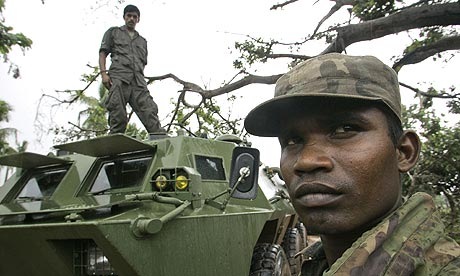 The Sri Lankan government today angrily rejected a US state department report containing allegations of human rights abuses in the final days of the country’s civil war, saying the document would fan further conflict.
The Sri Lankan government today angrily rejected a US state department report containing allegations of human rights abuses in the final days of the country’s civil war, saying the document would fan further conflict.
According to accounts a senior US state department official called "credible and well substantiated," government forces abducted and killed ethnic Tamil civilians, shelled and bombed no-fire zones, and killed senior rebel leaders with whom they had brokered a surrender.
Although the US stressed the allegations in the report did not constitute an accusation of war crimes, the Sri Lankan foreign affairs ministry in Colombo accused the US of smearing its reputation.
"The allegations against the government of Sri Lanka… appear to be unsubstantiated and devoid of corroborative evidence," the ministry said. "There is a track record of vested interests endeavouring to bring the government of Sri Lanka into disrepute, through fabricated allegations and concocted stories."
The report also includes allegations of violations by the defeated Tamil Tiger rebels, an organisation the US deems a terrorist group. It includes allegations that the rebels conscripted children as young as 12, used non-combatants as human shields, and gunned down civilians attempting to flee rebel-held areas.
Stephen Rapp, the US ambassador-at-large for war crimes, called on authorities in Sri Lanka to investigate allegations of abuse by both sides.
"We want accountability in this situation," he said. "We believe that [Sri Lankan authorities] can investigate this. We’re trusting in that commitment."
The 70-page report to Congress was compiled from intelligence reports from the US embassy in Colombo, text messages and photographs from inside the war zone, foreign government sources and reports from human rights and media organisations.
The report says it reaches no conclusions on the veracity of the charges, though Rapp said the individual sources are "credible and reliable," and that allegations had been corroborated.
"The US state department report should dispel any doubts that serious abuses were committed during the conflict’s final months," said Brad Adams, Asia director at Human Rights Watch. "Given Sri Lanka’s complete failure to investigate possible war crimes, the only hope for justice is an independent, international investigation."
The abuses are alleged to have occurred in the final months of the 25 year-long conflict, when the Sri Lankan military cornered the remnants of the rebel force in a grim strip of beach in the north-east of the island.
The report describes a hellish scene, in which a no-fire zone crowded with civilians was struck by sustained heavy shelling and bombing, with those who attempted to escape rebel-held areas mowed down by Tamil Tiger fighters.
One source in the no-fire zone estimated 100 people per day were dying in Sri Lankan army shelling and bombing. Another source said hospital facilities in the area were continually struck by shells, even though their locations had been carefully reported to the Sri Lankan government. According to a report cited, a congested civilian area of the no-fire zone came under heavy shell attack, killing hundreds of civilians.
The report cites video footage of Sri Lankan forces executing nine bound, naked captive Tamils in January, which the Sri Lankan government says was forged, and killings of young men rounded up in government-established safe zones. The US embassy and other governments reported that Tamil political leaders were killed while surrendering to government forces, the report said.
It came as more than 4,000 Tamils were released today from government-run camps where they have been held since May. Hundreds more remain in what the United Nations describes as internment camps with inadequate sanitation and healthcare. The Sri Lankan government has defended the measures, charging that Tamil Tiger fighters may still be hiding among the civilian refugees.
Since the end of fighting, the government has reintegrated fewer than 27,000 civilians, leaving an estimated 245,000 in the camps, according to Human Rights Watch. Last week, the Sri Lanka’s resettlement and disaster relief services minister Rishard Bathiudeen said the government plans to resettle 100,000 by the end of the year.
(For updates you can share with your friends, follow TNN on Facebook and Twitter )
